Geological Evolution of Rima Bode on the Moon Revealed by Multi-Source Remote Sensing Data
Highlights
- Based on compositional, topographic, and geomorphological analyses, we identified three distinct basaltic units and one pyroclastic deposit unit in the Rima Bode region, with thicknesses of 4.3–51.9 m for pyroclastic deposits and 2.3–269.2 m for basalts, establishing a quantitative stratigraphic framework. Based on Crater Size–Frequency Distribution (CSFD) Measurements, the model ages of the Rima Bode region range from 3.65 Ga to 3.27 Ga, indicating at least four distinct volcanic eruptions.
- MRM data reveal abnormal TB behaviors in pyroclastic deposits—exhibiting slower diurnal TB change rates compared to surrounding basalts—indicating significantly higher thermal inertia.
- This study systematically establishes, for the first time, a comprehensive geological evolution framework for the Rima Bode region, revealing its material composition, stratigraphic thickness characteristics, and potential volcanic source locations. The results provide crucial scientific evidence for a deeper understanding of the complex geological history in this region.
- The identification of high thermal inertia as a diagnostic signature of lunar pyroclastic deposits through microwave remote sensing provides a novel approach for distinguishing pyroclastic deposits from basaltic materials.
Abstract
1. Introduction
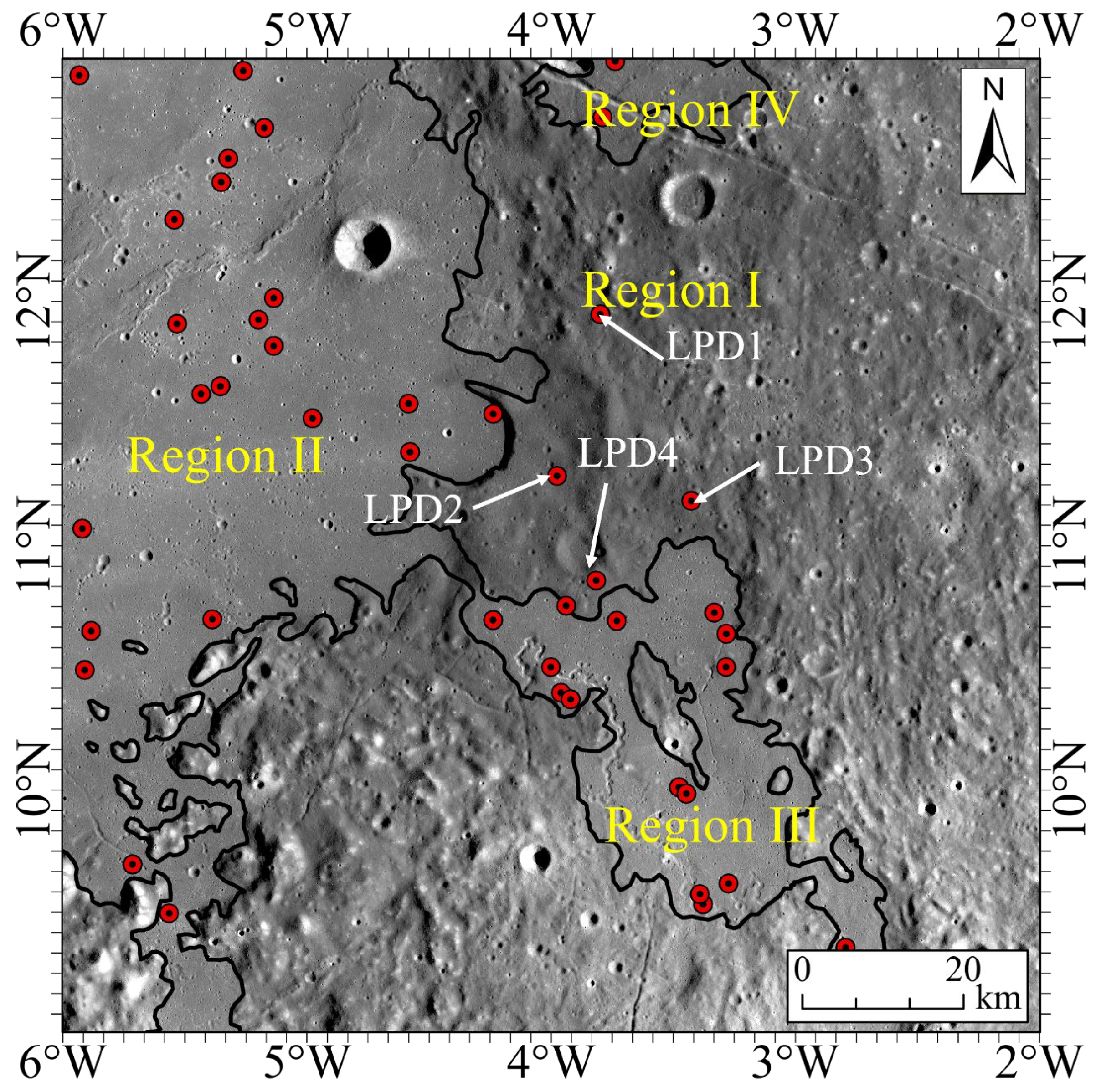
2. Data and Methods
2.1. Chang’E-2 (CE-2) Microwave Radiometer (MRM)
2.2. Crater Excavation Technique
2.3. Crater Size-Frequency Distribution (CSFD) Measurements
2.4. Complementary Datasets
3. Results
3.1. Geomorphological Characteristics
3.2. Composition of the Rima Bode
3.2.1. Spectral Properties
3.2.2. Chemical Composition
3.3. Thickness Estimation of Basalts and Pyroclastic Deposits
3.3.1. Estimation of Pyroclastic Deposits Thickness
3.3.2. Estimation of Basalt Thickness
3.4. Microwave Thermophysical Properties of the Rima Bode
3.5. Age of the Rima Bode
4. Discussion
5. Conclusions
Author Contributions
Funding
Data Availability Statement
Acknowledgments
Conflicts of Interest
References
- Neal, C.R.; Taylor, L.A. Petrogenesis of Mare Basalts: A Record of Lunar Volcanism. Geochim. Cosmochim. Acta 1992, 56, 2177–2211. [Google Scholar] [CrossRef]
- Head, J.W.; Wilson, L. Generation, Ascent and Eruption of Magma on the Moon: New Insights into Source Depths, Magma Supply, Intrusions and Effusive/Explosive Eruptions (Part 2: Predicted Emplacement Processes and Observations). Icarus 2017, 283, 176–223. [Google Scholar] [CrossRef]
- Shearer, C.K.; Hess, P.C.; Wieczorek, M.A.; Pritchard, M.E.; Parmentier, E.M.; Borg, L.E.; Longhi, J.; Elkins-Tanton, L.T.; Neal, C.R.; Antonenko, I. Thermal and Magmatic Evolution of the Moon. Rev. Mineral. Geochem. 2006, 60, 365–518. [Google Scholar] [CrossRef]
- Wilhelms, D.E.; McCauley, J.F. Geologic Map of the Near Side of the Moon; US Geological Survey: Reston, VA, USA, 1971.
- Hiesinger, H.; van Der Bogert, C.H.; Wedler, A.; Jaumann, R.; Mall, U.; Head, J.W.; Anand, M.; Jolliff, B.; Pinet, P.; Xiao, L. The Rima Bode Region-Absolute Model Ages of a Candidate Future Lunar Landing Site. In Proceedings of the 53rd Lunar and Planetary Science Conference, Woodlands, TX, USA, 7–11 March 2022; p. 2169. [Google Scholar]
- Pigue, L.M.; Bennett, K.A.; Horgan, B.H.; Gaddis, L.R. Relationship between Explosive and Effusive Volcanism in the Montes Apenninus Region of the Moon. J. Geophys. Res. Planets 2023, 128, e2023JE007861. [Google Scholar] [CrossRef]
- Jolliff, B.L.; Gillis, J.J.; Haskin, L.A.; Korotev, R.L.; Wieczorek, M.A. Major Lunar Crustal Terranes: Surface Expressions and Crust-mantle Origins. J. Geophys. Res. Planets 2000, 105, 4197–4216. [Google Scholar] [CrossRef]
- Gaddis, L.R.; Staid, M.I.; Tyburczy, J.A.; Hawke, B.R.; Petro, N.E. Compositional Analyses of Lunar Pyroclastic Deposits. Icarus 2003, 161, 262–280. [Google Scholar] [CrossRef]
- Ji, J.; Guo, D.; Liu, J.; Chen, S.; Ling, Z.; Ding, X.; Han, K.; Chen, J.; Cheng, W.; Zhu, K. The 1:2,500,000-Scale Geologic Map of the Global Moon. Sci. Bull. 2022, 67, 1544–1548. [Google Scholar] [CrossRef]
- Zhao, Z.; Chen, J.; Ling, Z.; Lu, X.; Li, Z. Chronology, Composition, and Mineralogy of Mare Basalts in the Junction of Oceanus Procellarum, Mare Imbrium, Mare Insularum, and Mare Vaporum. Icarus 2023, 397, 115531. [Google Scholar] [CrossRef]
- Weitz, C.M.; Head, J.W., III.; Pieters, C.M. Lunar Regional Dark Mantle Deposits: Geologic, Multispectral, and Modeling Studies. J. Geophys. Res. Planets 1998, 103, 22725–22759. [Google Scholar] [CrossRef]
- Fortezzo, C.M.; Spudis, P.D.; Harrel, S.L. Release of the Digital Unified Global Geologic Map of the Moon at 1:5,000,000-Scale. In Proceedings of the 51st Annual Lunar and Planetary Science Conference, Woodlands, TX, USA, 16–20 March 2020; p. 2760. [Google Scholar]
- Nelson, D.M.; Koeber, S.D.; Daud, K.; Robinson, M.S.; Watters, T.R.; Banks, M.E.; Williams, N.R. Mapping Lunar Maria Extents and Lobate Scarps Using LROC Image Products. In Proceedings of the 45th Annual Lunar and Planetary Science Conference, Woodlands, TX, USA, 17–21 March 2014; p. 2861. [Google Scholar]
- Zheng, Y.-C.; Chan, K.L.; Tsang, K.T.; Zhu, Y.-C.; Hu, G.P.; Blewett, D.T.; Neish, C. Analysis of Chang’E-2 Brightness Temperature Data and Production of High Spatial Resolution Microwave Maps of the Moon. Icarus 2019, 319, 627–644. [Google Scholar] [CrossRef]
- Siegler, M.A.; Feng, J.; Lehman-Franco, K.; Andrews-Hanna, J.C.; Economos, R.C.; Clair, M.S.; Million, C.; Head, J.W.; Glotch, T.D.; White, M.N. Remote Detection of a Lunar Granitic Batholith at Compton–Belkovich. Nature 2023, 620, 116–121. [Google Scholar] [CrossRef] [PubMed]
- Meng, Z.; Dong, X.; Lei, J.; Ping, J.; Cai, Z.; Zhang, X.; Huang, S.; Zhang, Y. Constructing a Complete Brightness Temperature Dataset of the Moon With Chang’e-2 Microwave Radiometer Data. IEEE Trans. Geosci. Remote Sens. 2023, 61, 1–14. [Google Scholar] [CrossRef]
- Lei, J.; Meng, Z.; Wang, Y.; Huang, S.; Ping, J.; Cai, Z.; Zhang, Y. Potential Applications of CE-2 Microwave Radiometer Data in Understanding Basaltic Volcanism in Heavily Ejecta-Contaminated Mare Frigoris. Remote Sens. 2022, 14, 2725. [Google Scholar] [CrossRef]
- Chang, W.; Meng, Z.; Xu, Y.; Zhang, X.; Bugiolacchi, R.; Xiao, L.; Ping, J.; Zhang, H.; Zhang, Y. Microwave Thermophysical Properties of Surface Deposits in CE-6 Landing Region and Its Potential Implications for Analyzing the Returned Samples. Earth Planet. Sci. Lett. 2025, 658, 119326. [Google Scholar] [CrossRef]
- Chen, Y.; Li, C.; Ren, X.; Liu, J.; Wu, Y.; Lu, Y.; Cai, W.; Zhang, X. The Thickness and Volume of Young Basalts Within Mare Imbrium. J. Geophys. Res. Planets 2018, 123, 630–645. [Google Scholar] [CrossRef]
- Qian, Y.; She, Z.; He, Q.; Xiao, L.; Wang, Z.; Head, J.W.; Sun, L.; Wang, Y.; Wu, B.; Wu, X.; et al. Mineralogy and Chronology of the Young Mare Volcanism in the Procellarum-KREEP-Terrane. Nat. Astron. 2023, 7, 287–297. [Google Scholar] [CrossRef]
- Melosh, H.J. Cratering Mechanics-Observational, Experimental, and Theoretical. Ann. Rev. Earth Planet. Sci. 1980, 8, 65–93. [Google Scholar] [CrossRef]
- Hiesinger, H.; Jaumann, R.; Neukum, G.; Head, J.W., III. Ages of Mare Basalts on the Lunar Nearside. J. Geophys. Res. Planets 2000, 105, 29239–29275. [Google Scholar] [CrossRef]
- Kneissl, T.; van Gasselt, S.; Neukum, G. Map-Projection-Independent Crater Size-Frequency Determination in GIS Environments—New Software Tool for ArcGIS. Planet. Space Sci. 2011, 59, 1243–1254. [Google Scholar] [CrossRef]
- Moriarty, D.P., III.; Pieters, C.M. Complexities in Pyroxene Compositions Derived from Absorption Band Centers: Examples from Apollo Samples, HED Meteorites, Synthetic Pure Pyroxenes, and Remote Sensing Data. Meteorit. Planet. Sci. 2016, 51, 207–234. [Google Scholar] [CrossRef]
- Savitzky, A.; Golay, M.J.E. Smoothing and Differentiation of Data by Simplified Least Squares Procedures. Anal. Chem. 1964, 36, 1627–1639. [Google Scholar] [CrossRef]
- Wu, Y.; Li, L.; Luo, X.; Lu, Y.; Chen, Y.; Pieters, C.M.; Basilevsky, A.T.; Head, J.W. Geology, Tectonism and Composition of the Northwest Imbrium Region. Icarus 2018, 303, 67–90. [Google Scholar] [CrossRef]
- Horgan, B.H.N.; Cloutis, E.A.; Mann, P.; Bell, J.F. Near-Infrared Spectra of Ferrous Mineral Mixtures and Methods for Their Identification in Planetary Surface Spectra. Icarus 2014, 234, 132–154. [Google Scholar] [CrossRef]
- Adams, J.B. Visible and Near-infrared Diffuse Reflectance Spectra of Pyroxenes as Applied to Remote Sensing of Solid Objects in the Solar System. J. Geophys. Res. 1974, 79, 4829–4836. [Google Scholar] [CrossRef]
- Cloutis, E.A.; Gaffey, M.J. Spectral-Compositional Variations in the Constituent Minerals of Mafic and Ultramafic Assemblages and Remote Sensing Implications. Earth Moon Planets 1991, 53, 11–53. [Google Scholar] [CrossRef]
- Klima, R.L.; Dyar, M.D.; Pieters, C.M. Near-Infrared Spectra of Clinopyroxenes: Effects of Calcium Content and Crystal Structure. Meteorit. Planet. Sci. 2011, 46, 379–395. [Google Scholar] [CrossRef]
- Klima, R.L.; Pieters, C.M.; Dyar, M.D. Spectroscopy of Synthetic Mg-Fe Pyroxenes I: Spin-Allowed and Spin-Forbidden Crystal Field Bands in the Visible and near-Infrared. Meteorit. Planet. Sci. 2007, 42, 235–253. [Google Scholar] [CrossRef]
- Zhu, C.; Deng, S.; Song, X.; Li, Y.; Wang, Q. Mamba Collaborative Implicit Neural Representation for Hyperspectral and Multispectral Remote Sensing Image Fusion. IEEE Trans. Geosci. Remote Sens. 2025, 63, 1–15. [Google Scholar] [CrossRef]
- Lucey, P.; Blewett, D.; Jolliff, B. Lunar Iron and Titanium Abundance Algorithms Based on Final Processing of Clementine Ultraviolet-Visible Images. J. Geophys. Res. Planets 2000, 105, 20297–20305. [Google Scholar] [CrossRef]
- Yang, C.; Zhang, X.; Bruzzone, L.; Liu, B.; Liu, D.; Ren, X.; Benediktsson, J.A.; Liang, Y.; Yang, B.; Yin, M.; et al. Comprehensive Mapping of Lunar Surface Chemistry by Adding Chang’e-5 Samples with Deep Learning. Nat. Commun. 2023, 14, 7554. [Google Scholar] [CrossRef]
- Qiao, L.; Xu, L.; Head, J.W.; Chen, J.; Zhang, Y.; Li, B.; Ling, Z. Geological Evidence for Extensive Basin Ejecta as Plains Terrains in the Moon’s South Polar Region. Nat. Commun. 2024, 15, 5783. [Google Scholar] [CrossRef]
- Yue, Z.; Li, W.; Di, K.; Liu, Z.; Liu, J. Global Mapping and Analysis of Lunar Wrinkle Ridges. J. Geophys. Res. Planets 2015, 120, 978–994. [Google Scholar] [CrossRef]
- Yue, Z.; Michael, G.G.; Di, K.; Liu, J. Global Survey of Lunar Wrinkle Ridge Formation Times. Earth Planet. Sci. Lett. 2017, 477, 14–20. [Google Scholar] [CrossRef]
- Thompson, T.J.; Robinson, M.S.; Watters, T.R.; Johnson, M.B. Global Lunar Wrinkle Ridge Identification and Analysis. In Proceedings of the 48th Annual Lunar and Planetary Science Conference, Woodlands, TX, USA, 20–24 March 2017; p. 2665. [Google Scholar]
- Hurwitz, D.M.; Head, J.W.; Hiesinger, H. Lunar Sinuous Rilles: Distribution, Characteristics, and Implications for Their Origin. Planet. Space Sci. 2013, 79, 1–38. [Google Scholar] [CrossRef]
- Zhang, F.; Zhu, M.-H.; Zou, Y.L. Late Stage Imbrium Volcanism on the Moon: Evidence for Two Source Regions and Implications for the Thermal History of Mare Imbrium. Earth Planet. Sci. Lett. 2016, 445, 13–27. [Google Scholar] [CrossRef]
- Zhang, F.; Head, J.W.; Wilson, L.; Meng, Y.; Wӧhler, C.; Guo, D.; Niu, S.; Bugiolacchi, R.; Qiao, L.; Dang, Y. Insights into Lunar Basaltic Volcanism from Mare Domes Superposed by Ring-moat Dome Structures (RMDSs) in Mare Tranquillitatis. J. Geophys. Res. Planets 2024, 129, e2023JE007969. [Google Scholar] [CrossRef]
- Jawin, E.R.; Besse, S.; Gaddis, L.R.; Sunshine, J.M.; Head, J.W.; Mazrouei, S. Examining Spectral Variations in Localized Lunar Dark Mantle Deposits. J. Geophys. Res. Planets. 2015, 120, 1310–1331. [Google Scholar] [CrossRef]
- Liu, D.; Wang, X.; Liu, J.; Liu, B.; Ren, X.; Chen, Y.; Chen, Z.; Zhang, H.; Zhang, G.; Zhou, Q. Spectral Interpretation of Late-Stage Mare Basalt Mineralogy Unveiled by Chang’E-5 Samples. Nat. Commun. 2022, 13, 5965. [Google Scholar] [CrossRef]
- Xu, Z.; Guo, D.; Liu, J. Maria Basalts Chronology of the Chang’E-5 Sampling Site. Remote Sens. 2021, 13, 1515. [Google Scholar] [CrossRef]
- Qian, Y.; Head, J.; Michalski, J.; Wang, X.; Van der Bogert, C.H.; Hiesinger, H.; Sun, L.; Yang, W.; Xiao, L.; Li, X. Long-Lasting Farside Volcanism in the Apollo Basin: Chang’e-6 Landing Site. Earth Planet. Sci. Lett. 2024, 637, 118737. [Google Scholar] [CrossRef]
- Trang, D.; Tonkham, T.; Filiberto, J.; Li, S.; Lemelin, M.; Elder, C.M. Eruption Characteristics of Lunar Localized Pyroclastic Deposits as Evidenced by Remotely Sensed Water, Mineralogy, and Regolith. Icarus 2022, 375, 114837. [Google Scholar] [CrossRef]
- Carter, L.M.; Campbell, B.A.; Hawke, B.R.; Campbell, D.B.; Nolan, M.C. Radar Remote Sensing of Pyroclastic Deposits in the Southern Mare Serenitatis and Mare Vaporum Regions of the Moon. J. Geophys. Res. Planets 2009, 114, E11. [Google Scholar] [CrossRef]
- Hu, G.-P.; Chan, K.L.; Zheng, Y.-C.; Xu, A.-A. A Rock Model for the Cold and Hot Spots in the Chang’E Microwave Brightness Temperature Map. IEEE Trans. Geosci. Remote Sens. 2018, 56, 5471–5480. [Google Scholar] [CrossRef]
- Mellon, M.T.; Jakosky, B.M.; Kieffer, H.H.; Christensen, P.R. High-Resolution Thermal Inertia Mapping from the Mars Global Surveyor Thermal Emission Spectrometer. Icarus 2000, 148, 437–455. [Google Scholar] [CrossRef]
- Neukum, G.; Ivanov, B.A.; Hartmann, W.K. Cratering Records in the Inner Solar System in Relation to the Lunar Reference System. Space Sci. Rev. 2001, 96, 55–86. [Google Scholar] [CrossRef]
- Yue, Z.; Di, K.; Wan, W.; Liu, Z.; Gou, S.; Liu, B.; Peng, M.; Wang, Y.; Jia, M.; Liu, J. Updated Lunar Cratering Chronology Model with the Radiometric Age of Chang’e-5 Samples. Nat. Astron 2022, 6, 541–545. [Google Scholar] [CrossRef]

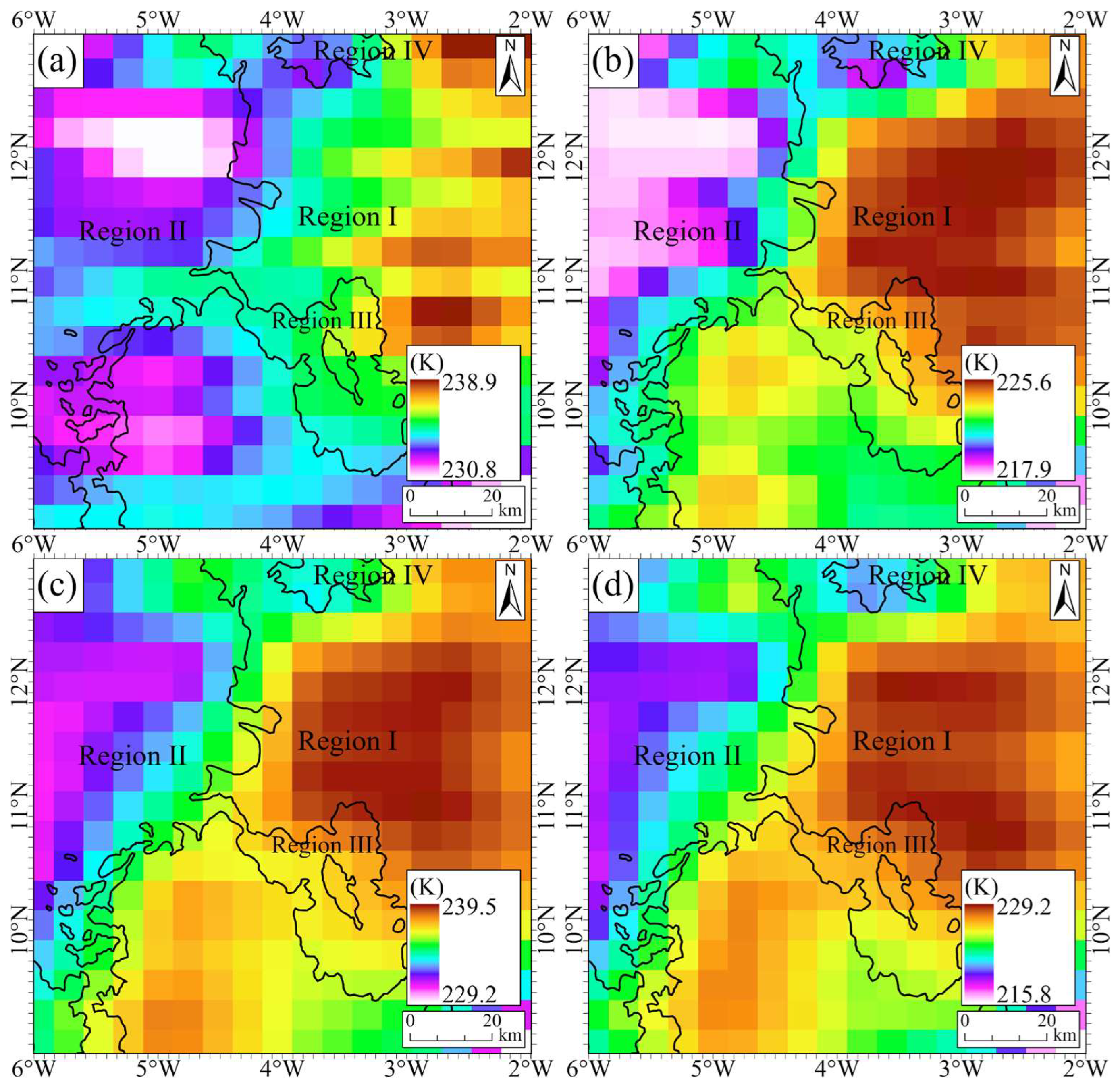


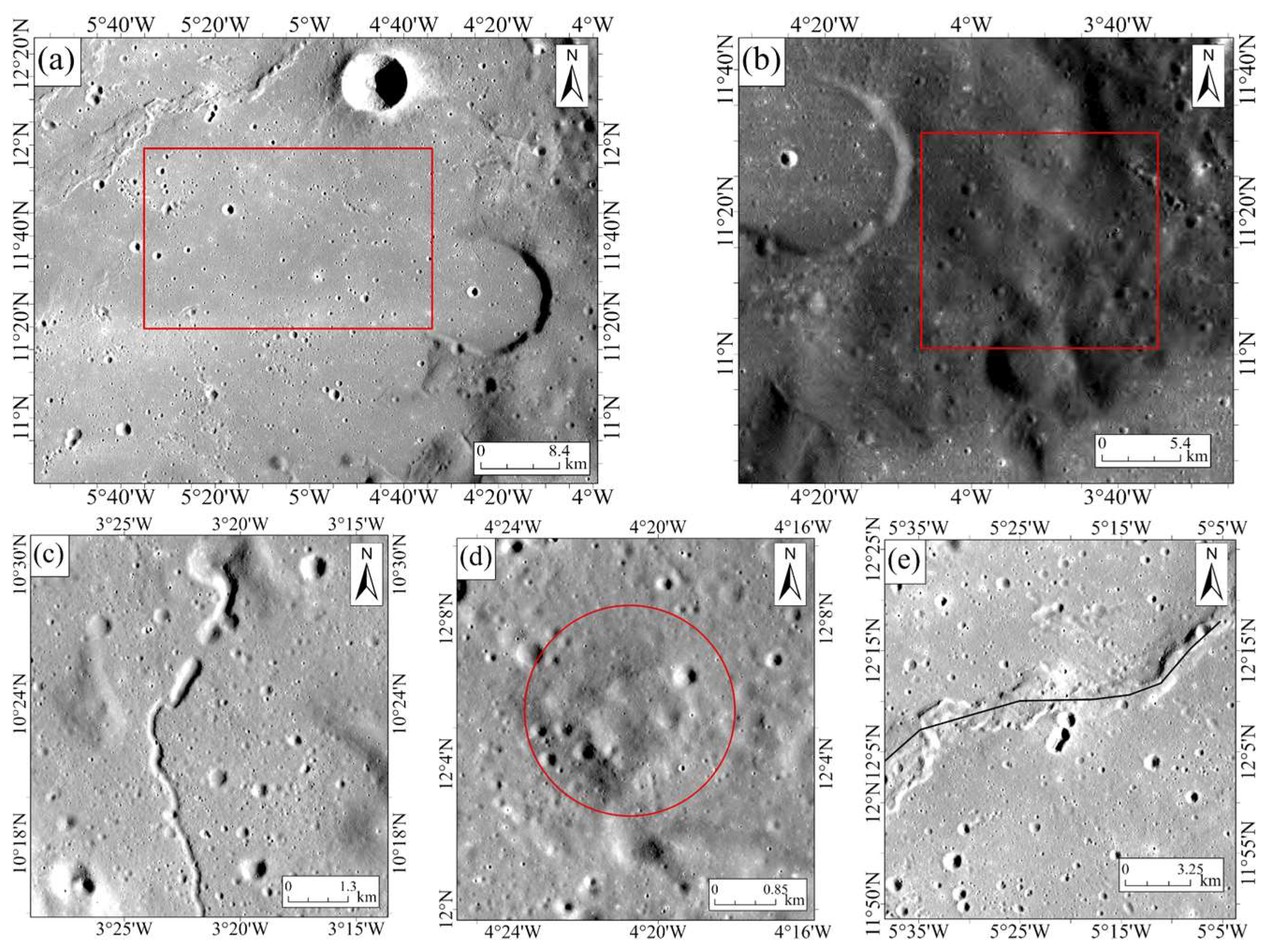





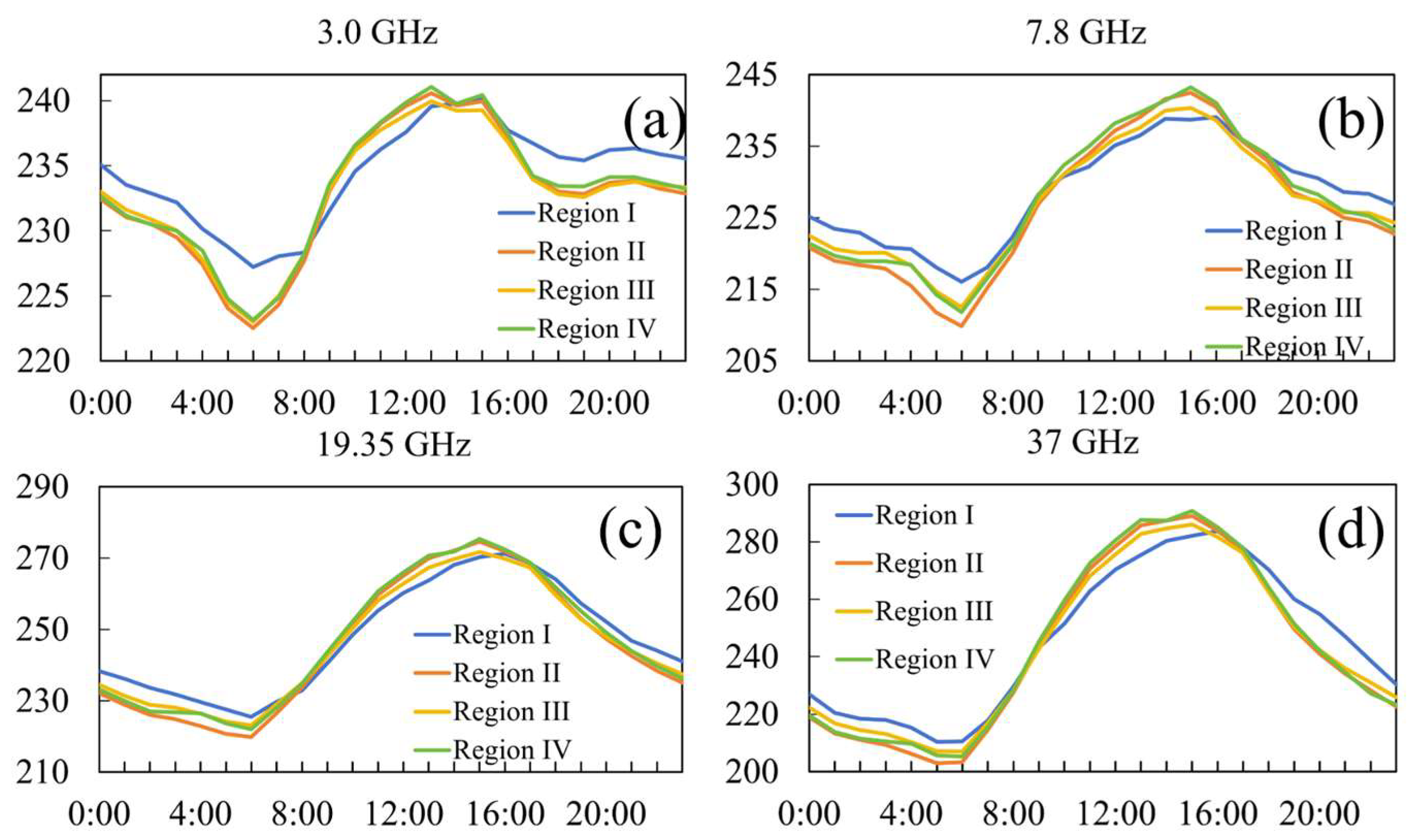
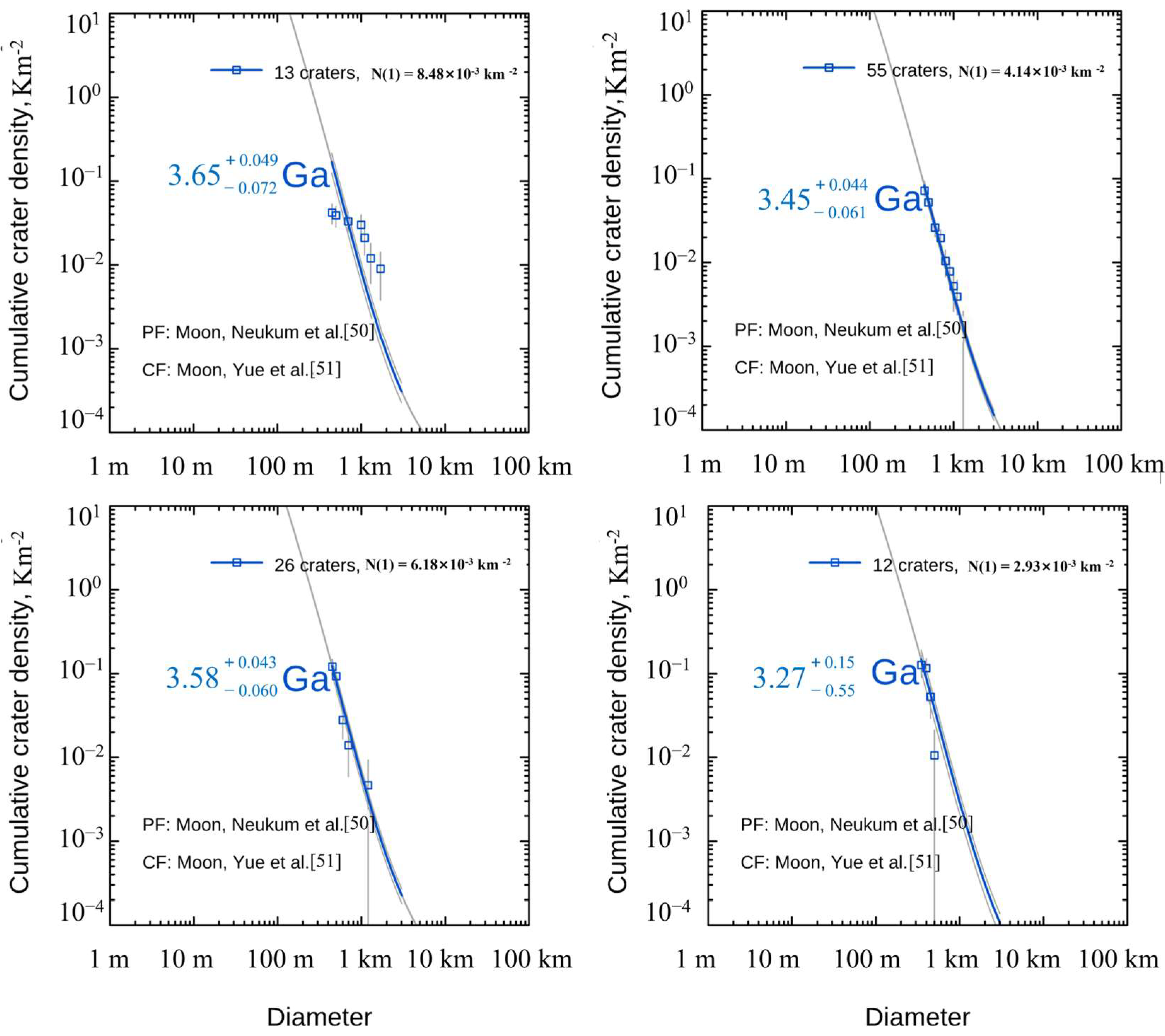
| Region I | Region II | Region III | Region IV | |
|---|---|---|---|---|
| FeO (wt.%) | 21.6 | 15.88 | 15.32 | 20.72 |
| TiO2 (wt.%) | 10.7 | 4.06 | 2.73 | 8.1 |
| 1000 nm Center | 1095.47 | 975.58 | 969.8 | 1030.79 |
| 2000 nm Center | 1958.14 | 2164.90 | 2124.71 | 2279.78 |
| Channels | Region I | Region II | Region III | Region IV | |
|---|---|---|---|---|---|
| noontime | 3.0 GHz | 237.6 | 239.5 | 236.4 | 242.8 |
| 7.8 GHz | 235.1 | 237.8 | 234.3 | 240.6 | |
| 19.35 GHz | 263.7 | 269.9 | 267.3 | 271.6 | |
| 37 GHz | 270.5 | 278.5 | 274.7 | 282.6 | |
| nighttime | 3.0 GHz | 237.6 | 233.4 | 235.2 | 231.7 |
| 7.8 GHz | 227.2 | 220.8 | 224.9 | 218.4 | |
| 19.35 GHz | 238.3 | 232.1 | 234.5 | 230.2 | |
| 37 GHz | 228.9 | 220.5 | 223.6 | 218.2 |
Disclaimer/Publisher’s Note: The statements, opinions and data contained in all publications are solely those of the individual author(s) and contributor(s) and not of MDPI and/or the editor(s). MDPI and/or the editor(s) disclaim responsibility for any injury to people or property resulting from any ideas, methods, instructions or products referred to in the content. |
© 2025 by the authors. Licensee MDPI, Basel, Switzerland. This article is an open access article distributed under the terms and conditions of the Creative Commons Attribution (CC BY) license (https://creativecommons.org/licenses/by/4.0/).
Share and Cite
Chang, W.; Meng, Z.; Bugiolacchi, R.; Xu, Y.; Zheng, Y.; Zong, Q.; Zhang, X.; Zhang, Y. Geological Evolution of Rima Bode on the Moon Revealed by Multi-Source Remote Sensing Data. Remote Sens. 2025, 17, 3824. https://doi.org/10.3390/rs17233824
Chang W, Meng Z, Bugiolacchi R, Xu Y, Zheng Y, Zong Q, Zhang X, Zhang Y. Geological Evolution of Rima Bode on the Moon Revealed by Multi-Source Remote Sensing Data. Remote Sensing. 2025; 17(23):3824. https://doi.org/10.3390/rs17233824
Chicago/Turabian StyleChang, Wenqing, Zhiguo Meng, Roberto Bugiolacchi, Yi Xu, Yongchun Zheng, Qiugang Zong, Xiaoping Zhang, and Yuanzhi Zhang. 2025. "Geological Evolution of Rima Bode on the Moon Revealed by Multi-Source Remote Sensing Data" Remote Sensing 17, no. 23: 3824. https://doi.org/10.3390/rs17233824
APA StyleChang, W., Meng, Z., Bugiolacchi, R., Xu, Y., Zheng, Y., Zong, Q., Zhang, X., & Zhang, Y. (2025). Geological Evolution of Rima Bode on the Moon Revealed by Multi-Source Remote Sensing Data. Remote Sensing, 17(23), 3824. https://doi.org/10.3390/rs17233824







